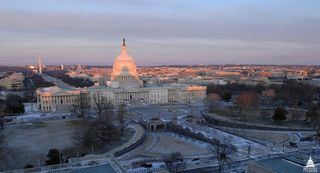Senators Offer Shapefile Broadband Mapping Bill

A bipartisan quartet of senators has introduced the latest effort to produce better data on where broadband is and isn't deployed, and it would rely on the shapefiles (a vector data format for storing geographic location information) cable op ISPs say is the way to go. The internet of things world has put a premium on such deployment because it considerably deepens the digital divide.
Everyone is pretty much in agreement that the current data is seriously flawed--legislators at an oversight hearing used even stronger language--but what to do about it is the sticky wicket.
Related: NCTA Defends Mapping Proposal
Sens. Shelley Moore Capito (R-W.Va.), Brian Schatz (D- Hawai‘i), Jerry Moran (R-Kan.), and Jon Tester (D-Mont.) have taken a shot at it via a new bill with a self-explanatory title, the Broadband Data Improvement Act.
The bill would require more accurate and granular data--both high on the list of the FCC and Congress--and subject that data to an "ongoing and multi-faceted challenge, validation, and refinement process."
Accruacy would come from replacing form 477 data collection with shapefiles that indicate "actual network coverage."
Validation would come from:
Multichannel Newsletter
The smarter way to stay on top of the multichannel video marketplace. Sign up below.
1. "The collection of public feedback regarding the accuracy of the map, obtained via a new feedback tool that will be integrated into the online mapping platform.
2. "The acquisition of third-party commercial datasets on broadband availability that areanalyzed and compared against provider-reported data.
3. "Targeted on-the-ground field validation of services in areas where public feedback andthird-party data suggest the map is incorrect."
There would be a periodic challenge process for the public and ISPs to challenge the map created by those shapefiles, with the FCC resolving any challenges and updating the map as needed.
Federal agencies--USDA, NTIA, FCC--would have to use the map to identify unserved areas and track awarded funds and smaller providers who can't afford the shapefile process would get help to make sure their numbers are as accurate as possible.
A "Charter" member of NCTA-The Internet & Television Association, which pushed the shapefile approach to better data, was singing the bill's praises.
“Charter applauds Senator Capito, Senator Schatz, Senator Moran, and Senator Tester for introducing legislation that would make national broadband mapping more accurate and granular and help close the digital divide, especially in rural areas," said the company in a statement. "For policymakers and those without broadband, obtaining accurate mapping information in a timely manner is incredibly important to ensure resources go to those in most need. Senator Capito’s bill which is informed by pilots that use shapefile methodology, will allow policymakers to quickly and cost effectively direct funds to those unserved areas that need it the most.”
“In order to bridge the digital divide, public and private partners need access to accurate and granular data," says Connect Americans Now (CAN) Executive Director Richard Cullen. "We applaud Senators Capito, Schatz, Moran and Tester for their continued focus on developing a more complete understanding of the digital divide impacting rural families."
Can took the opportunity to plug freeing up spectrum in the TV band for wireless broadband.
“[A]ccurate data alone will not connect rural America. While we urge the FCC to continue working with rural champions in Congress to improve its broadband maps," Cullen says. "It is also critical that we continue tearing down the regulatory barriers holding back TV white spaces technology and other innovative solutions that allow internet service providers to deliver broadband to rural consumers at a sustainable price."
“We are excited to see Senators Capito and Schatz introduce this critical measure to help bring the scope of the digital divide into clearer focus," said Morgan Reed, president of ACT | The App Association. "Reasonable minds differ on how best to deploy broadband infrastructure to connect the millions of Americans who currently lack a connection, but we can all agree that policy options must be informed by accurate, granular data. This legislation takes positive steps toward developing a more precise national broadband coverage map.
“Our member companies make innovative devices and applications across all sectors—from smart agriculture to connected health—that require strong, reliable broadband connections by any means available. However, it is difficult to bring these technologies to market in areas of the country lacking this access and doubly so when the federal government’s support mechanisms are based on broadband maps that are inconsistent with the reality on the ground for our members, their employees, and customers. We look forward to working with the Senators on this issue.”
Contributing editor John Eggerton has been an editor and/or writer on media regulation, legislation and policy for over four decades, including covering the FCC, FTC, Congress, the major media trade associations, and the federal courts. In addition to Multichannel News and Broadcasting + Cable, his work has appeared in Radio World, TV Technology, TV Fax, This Week in Consumer Electronics, Variety and the Encyclopedia Britannica.

